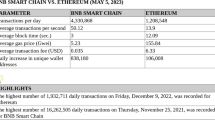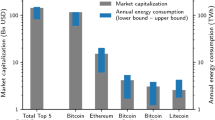Abstract
In recent years, there has been a growing interest in the potential of quantum computing for enhancing the security and efficiency of blockchain technology. While quantum blockchain protocols offer improved security over their classical counterparts, implementing such protocols on present-day quantum computers poses difficulties due to the limited number of qubits and quantum gates and the significant effects of noise. In this paper, we propose a set of improvements for implementing a quantum blockchain protocol based on hypergraphs that aim to reduce the required resources and operations and increase noise tolerance. Specifically, we focus on enhancing the state-of-the-art quantum circuits that underpin the quantum blockchain by optimizing the so-called T-count and T-depth, which represent the number of quantum gates and the circuit depth, respectively. Our proposed implementations also leverage proven error detection and correction codes to improve noise tolerance. To evaluate the effectiveness of our proposed improvements, we tested them on real quantum devices. Our results demonstrate a significant reduction in the T-count and T-depth. Overall, our proposed improvements provide a promising direction for the practical implementation of quantum blockchain protocols on current quantum computers and lay a foundation for further research in this area.






Similar content being viewed by others
Data Availability
Data sharing is not applicable to this article as no datasets were generated or analysed during the current study.
References
Orts, F., Ortega, G., Combarro, E.F., Garzón, E.M.: A review on reversible quantum adders. J. Netw. Comput. Appl. 170, 102810 (2020)
Paulavičius, R., Grigaitis, S., Igumenov, A., Filatovas, E.: A decade of blockchain: review of the current status, challenges, and future directions. Informatica 30(4), 729–748 (2019)
Wang, C., Li, X., Xu, H., Li, Z., Wang, J., Yang, Z., Mi, Z., Liang, X., Su, T., Yang, C.: Towards practical quantum computers: transmon qubit with a lifetime approaching 0.5 milliseconds. NPJ Quantum Inf 8(1), 1–6 (2022)
Anand, A., Schleich, P., Alperin-Lea, S., Jensen, P.W., Sim, S., Díaz-Tinoco, M., Kottmann, J.S., Degroote, M., Izmaylov, A.F., Aspuru-Guzik, A.: A quantum computing view on unitary coupled cluster theory. Chem. Soc. Rev. 51, 1659–1684 (2022)
Yang, Q., Zhao, Y., Huang, H., Xiong, Z., Kang, J., Zheng, Z.: Fusing blockchain and AI with metaverse: a survey. IEEE Open J Comput Soc 3, 122–136 (2022)
Sekar, S., Solayappan, A., Srimathi, J., Raja, S., Durga, S., Manoharan, P., Hamdi, M., Tunze, G.B.: Autonomous transaction model for e-commerce management using blockchain technology. Int J Inf Technol Web Eng 17(1), 1–14 (2022)
Fernandez-Carames, T.M., Fraga-Lamas, P.: Towards post-quantum blockchain: a review on blockchain cryptography resistant to quantum computing attacks. IEEE Access 8, 21091–21116 (2020)
Fedorov, A.K., Kiktenko, E.O., Lvovsky, A.I.: Quantum Computers Put Blockchain Security at Risk. Nature Publishing Group, Berlin (2018)
Unogwu, O.J., Doshi, R., Hiran, K.K., Mijwil, M.M.: Introduction to quantum-resistant blockchain. In: Advancements in Quantum Blockchain With Real-Time Applications, pp. 36–55. IGI Global, Pennsylvania, USA (2022)
Shor, P.W.: Polynomial-time algorithms for prime factorization and discrete logarithms on a quantum computer. SIAM Rev. 41(2), 303–332 (1999)
Jaques, S., Naehrig, M., Roetteler, M., Virdia, F.: Implementing Grover oracles for quantum key search on AES and LowMC. In: Advances in Cryptology–EUROCRYPT 2020: 39th Annual International Conference on the Theory and Applications of Cryptographic Techniques, Zagreb, Croatia, May 10–14, 2020, Proceedings, Part II 30, pp. 280–310 (2020). Springer
Grimes, R.A.: Cryptography Apocalypse: Preparing for the Day When Quantum Computing Breaks Today’s Crypto. Wiley, Hoboken (2019)
Li, Q., Wu, J., Quan, J., Shi, J., Zhang, S.: Efficient quantum blockchain with a consensus mechanism QDPoS. IEEE Trans. Inf. Forensics Secur. 17, 3264–3276 (2022)
Qu, Z., Zhang, Z., Zheng, M.: A quantum blockchain-enabled framework for secure private electronic medical records in internet of medical things. Inf. Sci. 612, 942–958 (2022)
Wang, W., Yu, Y., Du, L.: Quantum blockchain based on asymmetric quantum encryption and a stake vote consensus algorithm. Sci. Rep. 12(1), 1–12 (2022)
Nilesh, K., Panigrahi, P.K.: Quantum blockchain based on dimensional lifting generalized Gram–Schmidt procedure. IEEE Access 10, 103212–103222 (2022)
Krishnakumar, A.: Quantum Computing and Blockchain in Business: Exploring the Applications, Challenges, and Collision of Quantum Computing and Blockchain. Packt Publishing, Birmingham (2020)
Edwards, M., Mashatan, A., Ghose, S.: A review of quantum and hybrid quantum/classical blockchain protocols. Quantum Inf. Process. 19(6), 1–22 (2020)
Preskill, J.: Quantum computing in the NISQ era and beyond. Quantum 2, 79 (2018)
Nielsen, M.A., Chuang, I.L.: Quantum Computation and Quantum Information: 10th, Anniversary Cambridge University Press, Cambridge (2011)
Pelofske, E., Bärtschi, A., Eidenbenz, S.: Quantum volume in practice: What users can expect from NISQ devices. arXiv preprint arXiv:2203.03816 (2022)
De Luca, G.: A survey of NISQ era hybrid quantum-classical machine learning research. J. Artif. Intell. Technol. 2(1), 9–15 (2022)
Wei, S., Chen, Y., Zhou, Z., Long, G.: A quantum convolutional neural network on NISQ devices. AAPPS Bull. 32(1), 1–11 (2022)
Endo, S., Cai, Z., Benjamin, S.C., Yuan, X.: Hybrid quantum-classical algorithms and quantum error mitigation. J. Phys. Soc. Jpn. 90(3), 032001 (2021)
Bharti, K., Cervera-Lierta, A., Kyaw, T.H., Haug, T., Alperin-Lea, S., Anand, A., Degroote, M., Heimonen, H., Kottmann, J.S., Menke, T.: Noisy intermediate-scale quantum algorithms. Rev. Mod. Phys. 94(1), 015004 (2022)
Thapliyal, H., Muñoz-Coreas, E., Khalus, V.: Quantum circuit designs of carry lookahead adder optimized for T-count, T-depth, and qubits. Sustai. Comput. Inf. Syst. 29, 100457 (2021)
Lamport, L., Shostak, R., Pease, M.: The byzantine generals problem. In: Concurrency: The Works of Leslie Lamport, pp. 203–226 (2019)
Haber, S., Stornetta, W.S.: How to time-stamp a digital document. In: Menezes, A.J., Vanstone, S.A. (eds.) Advances in Cryptology-CRYPTO’ 90, pp. 437–455. Springer, Berlin (1991)
Bayer, D., Haber, S., Stornetta, W.S.: Improving the efficiency and reliability of digital time-stamping. In: Sequences II: Methods in Communication, Security, and Computer Science, pp. 329–334 (1993). Springer
Nakamoto, S.: Bitcoin: A peer-to-peer electronic cash system. https://bitcoin.org/bitcoin.pdf (2008)
Filatovas, E., Marcozzi, M., Mostarda, L., Paulavičius, R.: A MCDM-based framework for blockchain consensus protocol selection. Expert Syst. Appl. 204, 117609 (2022)
Bernhardt, C.: Quantum Computing for Everyone. Mit Press, Cambridge (2019)
Mohammadi, M., Eshghi, M.: On figures of merit in reversible and quantum logic designs. Quantum Inf. Process. 8(4), 297–318 (2009)
Thapliyal, H., Ranganathan, N.: Design of reversible sequential circuits optimizing quantum cost, delay, and garbage outputs. ACM J Emerg Technol Comput Syst 6(4), 1–31 (2010)
Orts, F., Ortega, G., Garzón, E.M.: An optimized quantum circuit for converting from sign-magnitude to two’s complement. Quantum Inf. Process. 18(11), 1–14 (2019)
Tan, Y.-Y., Cheng, X.-Y., Guan, Z.-J., Liu, Y., Ma, H.: Multi-strategy based quantum cost reduction of linear nearest-neighbor quantum circuit. Quantum Inf. Process. 17(3), 1–14 (2018)
Babukhin, D., Pogosov, W.: The effect of quantum noise on algorithmic perfect quantum state transfer on NISQ processors. Quantum Inf. Process. 21(1), 1–18 (2022)
Xue, C., Chen, Z.-Y., Wu, Y.-C., Guo, G.-P.: Effects of quantum noise on quantum approximate optimization algorithm. Chin. Phys. Lett. 38(3), 030302 (2021)
Orts, F., Ortega, G., Combarro, E.F., Rúa, I.F., Garzón, E.M.: Optimized quantum leading zero detector circuits. Quantum Inf. Process. 22(1), 1–17 (2023)
Gayathri, S., Kumar, R., Dhanalakshmi, S., Dooly, G., Duraibabu, D.B.: T-count optimized quantum circuit designs for single-precision floating-point division. Electronics 10(6), 703 (2021)
Roffe, J.: Quantum error correction: an introductory guide. Contemp. Phys. 60(3), 226–245 (2019)
Muñoz-Coreas, E., Thapliyal, H.: Quantum circuit design of a T-count optimized integer multiplier. IEEE Trans. Comput. 68(5), 729–739 (2018)
Paler, A., Polian, I., Nemoto, K., Devitt, S.J.: Fault-tolerant, high-level quantum circuits: form, compilation and description. Quantum Sci. Technol. 2(2), 025003 (2017)
Zhou, X., Leung, D.W., Chuang, I.L.: Methodology for quantum logic gate construction. Phys. Rev. A 62(5), 052316 (2000)
Kliuchnikov, V., Maslov, D., Mosca, M.: Practical approximation of single-qubit unitaries by single-qubit quantum Clifford and T circuits. IEEE Trans. Comput. 65(1), 161–172 (2015)
Paetznick, A., Svore, K.M.: Repeat-until-success: non-deterministic decomposition of single-qubit unitaries. arXiv preprint arXiv:1311.1074 (2013)
Forest, S., Gosset, D., Kliuchnikov, V., McKinnon, D.: Exact synthesis of single-qubit unitaries over Clifford-cyclotomic gate sets. J. Math. Phys. 56(8), 082201 (2015)
Kliuchnikov, V., Maslov, D., Mosca, M.: Fast and efficient exact synthesis of single qubit unitaries generated by Clifford and T gates. arXiv preprint arXiv:1206.5236 (2012)
Zhu, H.: Multiqubit Clifford groups are unitary 3-designs. Phys. Rev. A 96(6), 062336 (2017)
Bocharov, A., Roetteler, M., Svore, K.M.: Efficient synthesis of universal repeat-until-success quantum circuits. Phys. Rev. Lett. 114(8), 080502 (2015)
Combaro, E.F., González-Castillo, S.: A Practical Guide to Quantum Machine Learning and Quantum Optimization: Hands-on Approach to Modern Quantum Algorithms. Packt Publishing, United Kingdom (2023)
Younis, E., Sen, K., Yelick, K., Iancu, C.: Qfast: Conflating search and numerical optimization for scalable quantum circuit synthesis. In: 2021 IEEE International Conference on Quantum Computing and Engineering (QCE), pp. 232–243 (2021). IEEE
Gheorghiu, V., Mosca, M., Mukhopadhyay, P.: T-count and T-depth of any multi-qubit unitary. NPJ Quantum Inf 8(1), 1–10 (2022)
Gheorghiu, V., Mosca, M., Mukhopadhyay, P.: A (quasi-) polynomial time heuristic algorithm for synthesizing T-depth optimal circuits. NPJ Quantum Inf 8(1), 1–11 (2022)
Rossi, M., Huber, M., Bruß, D., Macchiavello, C.: Quantum hypergraph states. New J. Phys. 15(11), 113022 (2013)
Gühne, O., Cuquet, M., Steinhoff, F.E., Moroder, T., Rossi, M., Bruß, D., Kraus, B., Macchiavello, C.: Entanglement and nonclassical properties of hypergraph states. J. Phys. A: Math. Theor. 47(33), 335303 (2014)
Dutta, S., Sarkar, R., Panigrahi, P.K.: Permutation symmetric hypergraph states and multipartite quantum entanglement. Int. J. Theor. Phys. 58(11), 3927–3944 (2019)
Qu, R., Wang, J., Li, Z., Bao, Y.: Encoding hypergraphs into quantum states. Phys. Rev. A 87(2), 022311 (2013)
Kruszynska, C., Kraus, B.: Local entanglability and multipartite entanglement. Phys. Rev. A 79(5), 052304 (2009)
Tsimakuridze, N., Gühne, O.: Graph states and local unitary transformations beyond local Clifford operations. J. Phys. A: Math. Theor. 50(19), 195302 (2017)
Rajan, D., Visser, M.: Quantum blockchain using entanglement in time. Quantum Rep. 1(1), 3–11 (2019)
Li, C., Xu, Y., Tang, J., Liu, W.: Quantum blockchain: a decentralized, encrypted and distributed database based on quantum mechanics. J. Quantum Comput. 1(2), 49 (2019)
Banerjee, S., Mukherjee, A., Panigrahi, P.: Quantum blockchain using weighted hypergraph states. Phys. Rev. Res. 2(1), 013322 (2020)
Mohammadi, M., Eshghi, M.: On figures of merit in reversible and quantum logic designs. Quantum Inf. Process. 8(4), 297–318 (2009)
Orts, F., Ortega, G., Garzón, E.M.: Studying the cost of N-qubit Toffoli gates. In: International Conference on Computational Science, pp. 122–128 (2022). Springer
Amy, M., Maslov, D., Mosca, M.: Polynomial-time T-depth optimization of Clifford+ T circuits via matroid partitioning. IEEE Trans. Comput. Aided Des. Integr. Circuits Syst. 33(10), 1476–1489 (2014)
Gosset, D., Kliuchnikov, V., Mosca, M., Russo, V.: An algorithm for the T-count. arXiv preprint arXiv:1308.4134 (2013)
Gidney, C.: Halving the cost of quantum addition. Quantum 2, 74 (2018)
Funding
This research has received funding from the Research Council of Lithuania (LMTLT), agreement No. S-MIP-21-53.
Author information
Authors and Affiliations
Corresponding author
Ethics declarations
Conflict of interest
The authors declare that they have no competing interests.
Ethical approval
This article does not contain any studies with human participants or animals performed by any of the authors.
Additional information
Publisher's Note
Springer Nature remains neutral with regard to jurisdictional claims in published maps and institutional affiliations.
Rights and permissions
Springer Nature or its licensor (e.g. a society or other partner) holds exclusive rights to this article under a publishing agreement with the author(s) or other rightsholder(s); author self-archiving of the accepted manuscript version of this article is solely governed by the terms of such publishing agreement and applicable law.
About this article
Cite this article
Orts, F., Paulavičius, R. & Filatovas, E. Improving the implementation of quantum blockchain based on hypergraphs. Quantum Inf Process 22, 330 (2023). https://doi.org/10.1007/s11128-023-04096-w
Received:
Accepted:
Published:
DOI: https://doi.org/10.1007/s11128-023-04096-w




